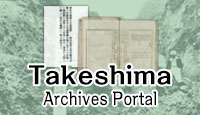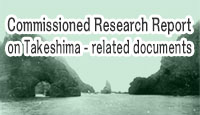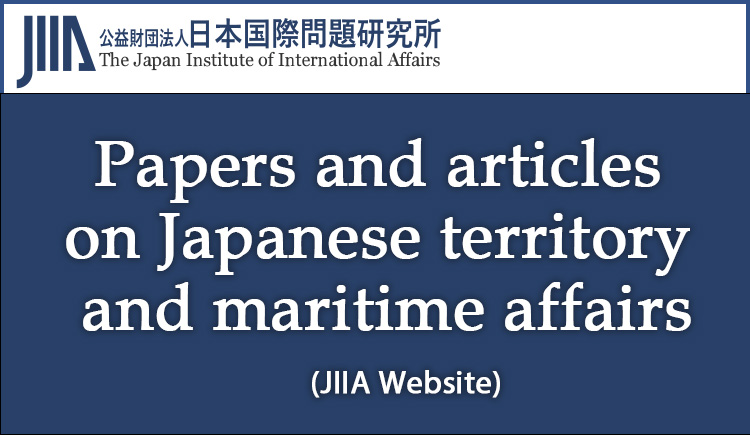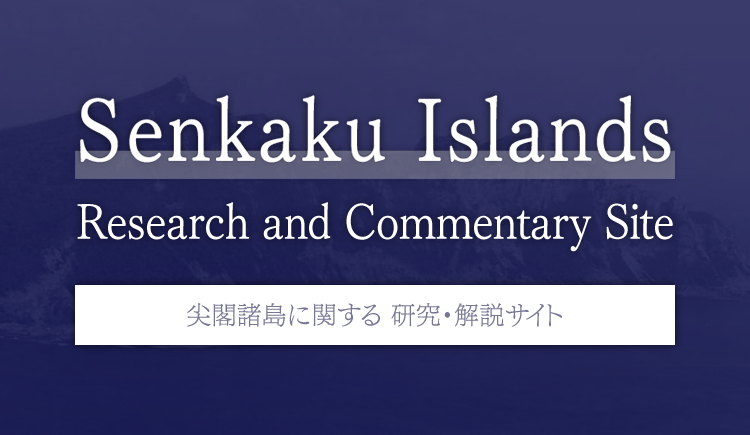The documents and materials published on this website were collected, researched, and prepared with advice from experts, as a part of a Government-commissioned project. The contents of this website do not reflect the views of the Government. Links to external sites (domains other than https://www.cas.go.jp) are not under the management of this site. For linked websites, please check with the organization/group that manages the website for the link in question.
Analysis of claims by other countries
Column Research and Education on ‘Dokdo’ in South Korea: Historical Premises
NAGASHIMA Hiroki (Professor, Kyushu University)
*Adobe Acrobat Reader DC, provided by Adobe, is needed to view the PDF files. If you do not have the software, please download it from the linked site. Adobe Acrobat Reader DCs
Introduction
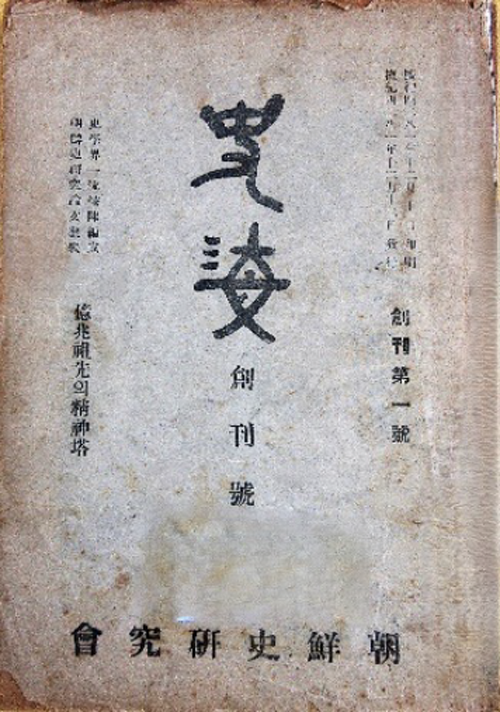
One of the earliest and most frequently cited academic studies on ‘Dokdo (Takeshima)’ in South Korea is an article titled ‘Belonging of Dokdo’ by Shin Seok-ho (1904–1981). This article was published in the inaugural issue of Sahae (史海), a historical journal released in December 1948 by the so-called Korean History Study Group, a collective of self-proclaimed Korean history researchers.
Although the journal is said to have ceased publication after its second issue, the fact that Yi Pyong-do (1896–1989), a prominent historian in Korea at the time, was listed as the chief executive of the Korean History Study Group suggests that this group functioned as a historical research division of the Jindan Academic Society (established in May 1934). The Jindan Academic Society had previously been commissioned by the U.S. military administration to compile history textbooks during the period of American military rule.
Shin Seok-ho’s article follows a highly orthodox methodology in attempting to prove Korea’s historical possession of Dokdo. It primarily relies on official chronological records, such as The Veritable Records of the Joseon Dynasty (李朝實錄), though it should be noted that these records were compiled posthumously for each king and are not real-time accounts, making them susceptible to embellishment and alteration. Furthermore, nearly all the academic papers and data cited in the article were of Japanese origin, indicating that it was largely based on pre-1945 academic research.
In other words, under Japanese rule in Korea, extensive and highly accurate “customs surveys” and “historic site surveys” were conducted under the initiative of the first governor-general, Terauchi Masatake. As a result, a large number of public records, including the “veritable records (實錄)” of each royal dynasty, which had been created during the old dynasties and stored in various “history archives” throughout the country, were gathered in Keijō (Seoul). After being organized at the “Counselor's branch Office” within Gyeongbokgung Palace, the former royal palace, it was eventually housed in the “Gyujanggak” as a special collection of Keijō Imperial University Library. Recent years, the Sejong Sillok Jiriji ((Geography Section of the Veritable Records King Sejong's Reign) (世宗実録地理志), which the ROK claims as one of the most authoritative historical documents proving its sovereignty over “Dokdo (Takeshima)”, is an appendix to the Sejong Sillok, a collection of historical records compiled after the death of King Sejong (r. 1418-1450), the fourth king of the Joseon Dynasty. Furthermore, between 1930 and 1932, staff members of the Faculty of Law and Literature at Keijō Imperial University took the lead in producing a facsimile edition of the veritable records of the 25th king of the Joseon Dynasty, titled The Veritable Records of the Joseon Dynasty, which consisted of 848 volumes in 30 sets. These were distributed to various universities and other institutions, leading to a significant advancement in the academic research on the Joseon Dynasty.
As will be discussed later, Shin Seok-ho, who graduated from the Department of History at Keijō Imperial University in March 1930, worked for many years as a historian for the Government-General of Chosen (Korea) immediately after graduation, and was in a position to directly access such historical materials. Therefore, in the articles of the issue of Sahae, in addition to the official records of successive kings, the paper cites basic historical materials stored in the Gyujanggak (now the Gyujanggak Institute for Korean Studies at Seoul National University) that are still used in academic research today, such as the Ilseongnok (日省錄), Seungjeongwon ilgi (承政院日記), Sinjeung Dongguk Yeoji Seungnam(新增東國輿地勝覽), and Tongmun-hwigo (同文彙考), as well as many Japanese studies and gazetteers, including the paper by Professor Tabohashi Kiyoshi, who was his mentor. His argument in the articles of the issue of Sahae was based on the achievements made prior to 1945.
1. ‘Korean History’ Education in the Academic Affairs Bureau of the Government-General of Chosen (Korea)
It is often assumed, without any evidence, that ‘Korean history’ was erased, and that no education was provided during the Japanese rule. This is completely incorrect. Rather, it is undeniable that the Government-General of Chosen (Korea) took the lead in attempting to disseminate Korean history through textbooks by dividing historical periods into categories based on historical materials, or by compiling a ‘Comprehensive chronological history of Korea’ by themes such as political history, economic history, and cultural history.
At the centre of this effort was Oda Shōgo (1871–1953), an academic affairs official. Oda was part of the generation that studied German-style empirical history at the Department of History in the College of Letters, when there was only one Imperial University. He was despatched to the Korean Empire at that time, while still serving as a professor at the First Higher School and was mainly involved in producing textbooks.
Even after the annexation of Korea in August 1910, he continued to work at the Government-General of Chosen (Korea) as chief of the editorial section of the Academic Affairs Bureau. He also worked diligently to establish an academic organisation consisting of government officials and teachers. In the 1920s, he published a monthly Korean History Lecture (Nos. 1–15, Sept. 1923 – Nov. 1924) under the name of the Korean History Society, providing guidelines for the education of Korean history to schoolteachers across Korea.
Oda also served as the dean of the preparatory course at Keijō Imperial University, which was established in the 1924 academic year, and began exploring the future direction of Korean history education. One of the results of this effort was the establishment of the Department of History within the Faculty of Law and Literature, which opened in the 1926 academic year, two years after the preparatory course. Within this department, Korean History was offered as one of its specialised fields.
2. Korean History Division, Department of History, Faculty of Law and Literature, Keijō Imperial University
At the newly established Keijō Imperial University, the Faculty of Law and Literature housed two Korean history chairs. The first chair as led by Professor Oda Shōgo, while the second chair as under Professor Imanishi Ryū, who specialised in ancient history. However, Oda retired in the 1931 academic year, and following Imanishi's death in 1932, the first course was taken over by Suematsu Yasukazuand the second course by Fujita Ryōsaku, an expert in archaeology and ancient history, both of whom remained in their positions until August 1945.
At Keijō Imperial University, numerous scholars were involved in Korean studies, not only within the humanities division of the Faculty of Law and Literature but also in the law division and even within the Faculty of Medicine. For example, Nakamura Hiroshi who later made significant contributions to the studies on maps of Takeshima in postwar Japan, was a professor in the Faculty of Medicine.
Notably, Tabohashi Kiyoshi (1897–1945), a professor in the first Japanese history course, specialised in the history of foreign relations during the late Tokugawa shogunate and the Meiji Restoration. His research interests expanded to include modern Japan-Korea relations, utilising diplomatic materials from Europe and the United States. Furthermore, in the latter half of the Korean History compilation project (specifically in the modern history segment) by the Korean History Compilation Society which will be described later, Tabohashi effectively took the lead. Additionally, it was Tabohashi who authored the first empirical paper on the transition of the name of Takeshima by extensively researching historical materials from both Eastern and Western sources (Seikyū Gakusō, vols. 3 and 4, 1931). Shin Seok-ho’s previously mentioned article was based on Tabohashi's thesis.
3. From the Korean History Compilation Society to the National History Compilation Committee
Now, let us turn to the Korean History Compilation Society. Initially, under the Government-General of Korea, the Interrogation Bureau and Counselor's Office, which inherited the real estate law research and legal code research conducted at the end of the Korean Empire, consolidated various records of the former dynasty in Keijō (now Seoul) and catalogued them with book numbers. This ‘book classification’ process was conducted as part of the Old Customs and Institutional Survey and was carried out prior to the compilation of Korean history.
However, the Counselor's Office was soon abolished, and in May 1915, the work related to the Old Customs and Institutional Survey was transferred to the Central Council, an advisory body to the Government-General of Korea, which was originally composed of influential Korean figures. At that time, the compilation of The History of the Korean Peninsula had already started as a project of the Central Council in January 1915. However, since this compilation was managed by bureaucrats from the Ministry of Justice, it became a subject of contention over leadership with the Education Bureau, which had also inherited part of the project from the Counselor’s Office. As a result, the compilation was ultimately suspended.
Following the March 1st Independence Movement (1919), the so-called ‘Cultural Policy’ era began, and with it, the Korean History Compilation Committee (Chōsen-shi Hensan Iinkai) was newly organized in December 1922. To further advance this project, the committee was institutionalized as the Korean History Compilation Society (Chōsen-shi Henshūkai) in June 1926.
The compilation and publication of Korean History, which was positioned as the main task of the Korean History Compilation Society, was carried out from 1932 to 1938, and the collection and organization of related historical materials were also conducted in parallel. This was essentially an attempt to compile a chronological collection of historical materials modeled after the Great History of Japan (Dai Nihon Shiryō), which had originated from the compilation of the “Chronological History of the Great Japan” during the Meiji period.
The practical work of compiling these historical materials was carried out by government officials in positions such as ‘historian’, ‘assistant historian’, ‘secretary’ and ‘commissioned historian’. Initially, Inaba (Kunzan) Iwakichi, a historian specializing in history and a disciple of Naitō (Konan) Torajirō, played a central role in the compilation. Other scholars appointed included Fujita Ryōsaku, Nakamura Hidetaka and Suematsu Yasukazu, all graduates of the Department of Japanese History at Tokyo Imperial University. Additionally, graduates from the Department of Korean History at Keijō Imperial University, such as Shin Seok-ho and Tagawa Kōzō, were hired successively. Yi Pyong-do, a graduate of Waseda University, also worked as a junior official historian for a short period (August 1925 – May 1927) and continued to contribute as a commissioned historian even after his retirement.
By the time the compilation of Korean History was completed, Inaba had been transferred to a professorship at Manchurian Kenkoku (Jiànguó) University (1937) in Manchukuo, Suematsu had already been appointed as an assistant professor at Keijō Imperial University (1935), and Nakamura Hidetaka had been reassigned as an editor in the Academic Affairs Bureau of the Government-General of Korea, responsible for compiling national textbooks. Meanwhile, Shin Seok-ho oversaw the Korean History Compilation Society during the war as the chief historian.
Conclusion
After the “liberation” of Korea, under U.S. rule, the Korean History Compilation Society was reestablished as the National History Institute (Kokushi-kan/Kuksa-gwan), with Shin Seok-ho playing a central role in this process. In July 1949, the National History Institute was reorganized into the National History Compilation Committee (Kokushi Hensan Iinkai/Kuksa Peonchan Wiwonhoe) under the Ministry of Education.
In South Korea, from 1947 to 1973, official history textbooks were used (with some subjects also state-designated). However, in 1974, all history textbooks were changed to state-designated textbooks. During the summer of 1982, the so-called ‘textbook issue,’ which had long been a subject of debate over the reintroduction of the ‘official’ system, led to the publication of official textbooks under the name of the Committee for the Development of Class-1 Books. However, there was only one textbook per subject for both middle and high schools, making them effectively state-designated textbooks. The difference was that, instead of being written by editors from the Ministry of Education, these textbooks were compiled by university professors and middle and high school teachers commissioned by the committee.
Thus, the compilation of history textbooks in South Korea became a process through which the ‘legitimate history of the state’ or ‘national history’ was written. If we trace the origins of these textbooks even slightly, we can immediately identify their connection to historiography and history education in Korea under Japanese rule.
Takeshima
Research and Commentary Site
- I Comprehensive issues
- II Commentary on themes by historical period
- III Analysis of claims by other countries

